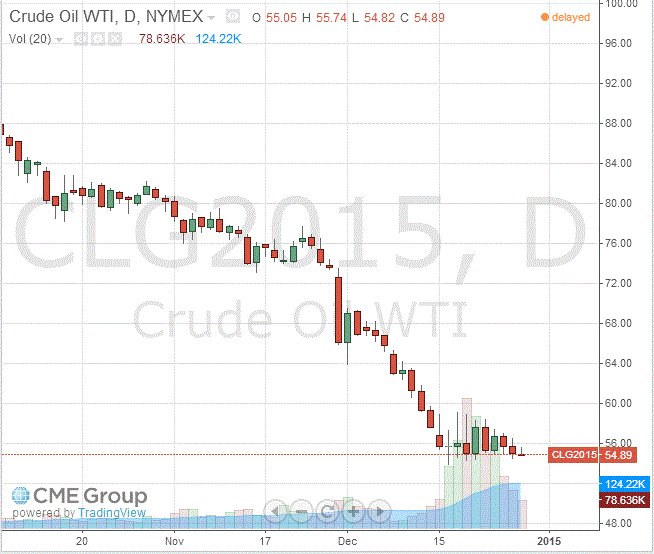- Oil: A review of the market situation
Market news
Oil: A review of the market situation
Oil futures traded at a moderate decrease after rising more than 1.5% earlier today, which was caused by speculation that the escalation of the conflict in Libya may reduce the global supply of oil.
As it became known, December 25 largest oil port of Libya, Es Sider, which holds about 6.2 million barrels of oil, the fire started on five of the six oil tanks as a result of shelling by the Islamist armed groups. Since then, the fire was extinguished in two tanks, but the loss of oil are estimated at 850 thousand. Barrels. "The situation in Libya bit helps reduce supply on the market, - the expert said Mizuho Securities Bob Yeager. - However, the proposal is still very much greater than demand, and quotes are dangerously close to multi-year lows. The minimum pressure is enough to those lows again become a reality ".
It is worth emphasizing that oil prices have fallen 46 percent this year, which is the largest annual decline since 2008, as the Organization of Petroleum Exporting Countries opposed the reduction of production to protect market share in response to increased output in the United States over the past three decades .
Little impact continues to report from the Energy Information Administration, which showed that commercial oil stocks rose 7.3 million barrels to 387.2 million barrels, while the average forecast assumes a decrease of 1.8 million barrels. Gasoline inventories rose by 4.1 million barrels to 226.1 million barrels. Distillate stocks rose 2.3 million barrels to 123.8 million barrels, while analysts had expected a decline of 900,000 barrels. Utilization rate of refining capacity has remained at around 93.5%. Earlier, analysts expected a decrease in the index by 0.2 percentage points.
According to the analyst Phillip Futures Daniel Ang, this week will be traded Brent at around $ 60 per barrel and WTI in the range of $ 55-56. Support prices give cover short positions and plans for China and Japan to increase liquidity. As previously reported, the Japanese government approved a package of fiscal stimulus at 3.5 trillion. yen in order to accelerate the economy after the tax increase with sales in April led to a decline in consumer demand. The measures include vouchers for purchases, subsidized fuel for heating (for the poor), loans with low interest rates for small business (which was under the pressure of rising costs included). The government estimates that an additional GDP growth may be 0.7%. Economic Development Minister Amari said yesterday that the cost will be paid by revenues and unspent funds, and will not require a new bond issue.
The cost of the February futures on US light crude oil WTI (Light Sweet Crude Oil) dropped to 54.89 dollars per barrel on the New York Mercantile Exchange.
February futures price for North Sea Brent crude oil mix fell $ 0.52 to $ 59.33 a barrel on the London Stock Exchange ICE Futures Europe.
